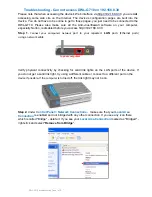
Chapter 2: Bridging Configuration Guide
2 - 4
SSR User Reference Manual
to remember the types of VLANs in order to configure the SSR, as seen in the section
on configuring the SSR.
VLANs and the SSR
VLANs are an integral part of the SSR family of switching routers. The SSR switching
routers can function as layer-2 (L2) switches as well as fully-functonal layer-3 (L3)
routers. Hence they can be viewed as a switch and a router in one box. To provide
maximum performance and functionality, the L2 and L3 aspects of the SSR switching
routers are tightly coupled.
The SSR can be used purely as an L2 switch. Frames arriving at any port are bridged
and not routed. In this case, setting up VLANs and associating ports with VLANs is
all that is required. You can set up the SSR switching router to use port-based VLANs,
protocol-based VLANs, or a mixture of the two types.
The SSR can also be used purely as a router, i.e., each physical port of the SSR is a
separate routing interface. Packets received at any interface are routed and not bridged.
In this case, no VLAN configuration is required. Note that VLANs are still created
implicitly by the SSR as a result of creating L3 interfaces for IP and/or IPX. However,
these implicit VLANs do not need to be created or configured manually. The implicit
VLANs created by the SSR are subnet-based VLANs.
Most commonly, an SSR is used as a combined switch and router. For example, it may
be connected to two subnets S1 and S2. Ports 1-8 belong to S1 and ports 9-16 belong
to S2. The required behavior of the SSR is that intra-subnet frames be bridged and
inter-subnet packets be routed. In other words, traffic between two workstations that
belong to the same subnet should be bridged, and traffic between two workstations that
belong to different subnets should be routed.
The SSR switching routers use VLANs to achieve this behavior. This means that a L3
subnet (i.e., an IP or IPX subnet) is mapped to a VLAN. A given subnet maps to
exactly one and only one VLAN. With this definition, the terms VLAN and subnet are
almost interchangeable.
To configure an SSR as a combined switch and router, the administrator must create
VLANs whenever multiple ports of the SSR are to belong to a particular VLAN/
subnet. Then the VLAN must be bound to an L3 (IP/IPX) interface so that the SSR
knows which VLAN maps to which IP/IPX subnet.
Ports, VLANs, and L3 Interfaces
The term port refers to a physical connector on the SSR, such as an ethernet port. Each
port must belong to at least one VLAN. When the SSR is unconfigured, each port
belongs to a VLAN called the “default VLAN”. By creating VLANs and adding ports
to the created VLANs, the ports are moved from the default VLAN to the newly
created VLANs.
Summary of Contents for SmartSwitch 8-slot
Page 1: ...SmartSwitch Router User Reference Manual 9032578...
Page 2: ......
Page 6: ...Notice vi...
Page 10: ...About This Manual x SSR User Reference Manual...
Page 36: ...Chapter 1 SmartSwitch Router Product Overview 1 18 SSR User Reference Manual...
Page 60: ...Chapter 4 RIP Configuration Guide 4 6 SSR User Reference Manual...
Page 115: ...Chapter 7 Multicast Routing Configuration Guide SSR User Reference Manual 7 9...
Page 116: ...Chapter 7 Multicast Routing Configuration Guide 7 10 SSR User Reference Manual...
Page 142: ...Chapter 9 Security Configuration Guide 9 18 SSR User Reference Manual...
















































